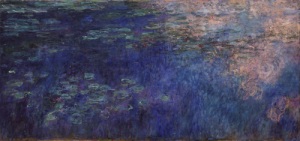
Walead Beshty, "Three Color Curl"
“New Photography 2009” is jarring. Not so much because of the content of the installed works, but because these brightly colored, mega-prints stand as loud foils to the petite black and white historical photographs that line the preceding galleries. Toto, we’re not using film anymore.
Photographer as Artist, that is, the photographer as the creator of an image rather than a mere recorder of a scene, has been a subject of discussion since photography’s inception. In New Photography 2009, there is no question that the photographers are the brains and eyes behind these images. Walead Beshty’s monolith fluorescent prints are produced entirely in the darkroom without ever using a camera. They’re like a neon-visualization of a John Cage composition — their patterns are entirely random. Leslie Hewitt’s upside-down still-lives drive home that she is in control of her art while Daniel Gordon’s grotesque collage figures remind us that beauty is a construct, in this case of the photographer.
New Photography is interesting, mostly for the contrast between the recent works and the older photographs. While the galleries are short on art historical contextualization (there seems to be little sense of evolution from the early tintypes to the contemporary prints), the new installation is still captivating.
To me, Photography is a dying art. Maybe that’s not fair. It’s a certainly a changing and troubled art. Photography has moved so far away from its beginnings that today’s “art photographs” are almost unrecognizable as photographs. The 6 artists of New Photography fabricate their own scenes, tinker with them, photograph and rephotograph, photoshop and rephotoshop, until their vision is conveyed in a chromogenic print that may or may not look like something out of the real world. Whatever happened to photographers capturing fleeting moments or the soul of their sitter in a single frame? Sure there’s a lot of talented people with cameras doing that, but the artists seen this fall at MoMA are not among them.
 Monumental. Sublime. Enveloping. Inescapable. Soothing. Disorienting.
Monumental. Sublime. Enveloping. Inescapable. Soothing. Disorienting. Ron Arad: No Discipline
Ron Arad: No Discipline Antonelli deserves praise for making a potentially disjointed retrospective logical and easily legible. You don’t need to know a lot about design or Ron Arad to walk away with the exhibition’s thesis. Just look and you’ll get the picture. Antonelli opted to replace typical wall-labels with animated monitors. Short videos construct and deconstruct each object on view, revealing both Arad’s process and the piece’s practical use. Written text is comparatively inadequate — especially in dealing with the work of a designer who takes process and function so seriously. For those that feel the need for some more traditional text, there’s a map out side the door with all the typical wall label information. Still need more info? There’s always the audio guide (which I understand is better than the audioguide for the permanent collection).
Antonelli deserves praise for making a potentially disjointed retrospective logical and easily legible. You don’t need to know a lot about design or Ron Arad to walk away with the exhibition’s thesis. Just look and you’ll get the picture. Antonelli opted to replace typical wall-labels with animated monitors. Short videos construct and deconstruct each object on view, revealing both Arad’s process and the piece’s practical use. Written text is comparatively inadequate — especially in dealing with the work of a designer who takes process and function so seriously. For those that feel the need for some more traditional text, there’s a map out side the door with all the typical wall label information. Still need more info? There’s always the audio guide (which I understand is better than the audioguide for the permanent collection).